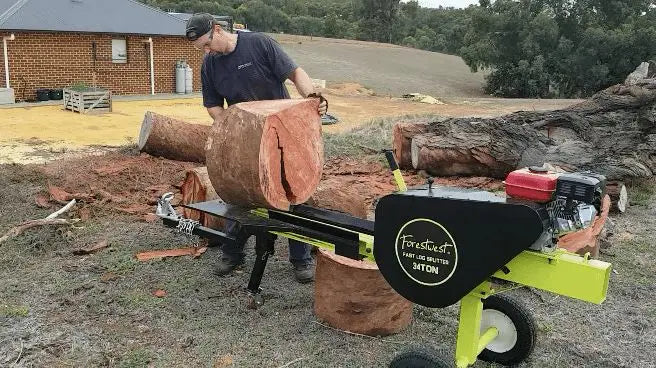How to prepare your firewood in US?
Preparing the firewood for domestic use can be very simple but also essential for efficient firewood heating. The whole process include Cutting and Splitting, Stacking and Storing, Seasoning (Drying).Cutting and Splitting:
Apparently you can avoid this step if you purchase pre-split firewood from wood supplier, but there will always a few pieces that won’t fit in your stove.For cutting firewood, the rule of thumb is the firewood should be 3 inches shorter than the stove length or width. In general it is better to split them a little shorter than longer, because it’s easier to dry and handle. And it is recommended to cut your firewood to a similar length for convenient use. Cutting with a chainsaw is probably the most common way, you can also purchase a Log Stand or Chainsaw Stand to avoid hitting the ground and damaging the chainsaw. And of course, if you have tons of wood to cut, you can also invest in a Log Cutting Saw or a Log Bench Saw, it do cost a bit more, but it’s a lot more efficient and safer, because you just need to load the firewood onto the bench, stay behind it and push it against the blade.
The next step is splitting, for efficient burning, you should split firewood less than 6 inches at the cross sectional dimension. And of course, it’s always good to split the firewood into a range of sizes so when kindling a fire or reloading on a coal bed, you have smaller pieces to reach instant ignition. The cheapest way to split firewood is using an axe or other manual splitting tools, but bear in mind, it will stress your shoulder and back, so it’s always feasible to invest into a Log Splitter, especially when you have tons of firewood to split and dry. You can check our Kinetic Log Splitter for speedy action and minimum maintenance.
Stack and Store
Properly stack and store your firewood will help speed up the seasoning process, so they burn better. The optimum goal is to pile the wood so sun can warm it and the wind can blow through it. The quickest way is to buy a pre-build Log Rack, so the wood is lifted up so the water from the ground do not have access to go back into the firewood. And try to stack your wood loose enough so the air can blow through it. Keep some of the firewood in a separated Log Rack will help speed up the seasoning process.The most recommended structure is to pile them in a single windrow, so every piece can be exposed the most to sun and wind. If you don’t have enough space to stack them in one row, you can stack them in a few rows but leave some spaces between rows for the sun and wind to penetrate the stacks.
Storing the firewood for drying can be tricky sometimes, if you don’t have a cover shed or storage area, put you firewood with the bark side on top, because the bark side is a natural barrier and prevent some of the rain off your firewood.
Seasoning (drying)
Seasoning means drying your wood in a season and prepare them for winter. Freshly cut firewood has a lot of moisture, in fact up to 45% of its weight is made up of water. It’s hard to start the fire and just as hard to keep them burning, and the energy is wasted on drying the wood instead of heating your house, let alone the smoke that will blacken everything near the fire. On the other hand, the seasoned firewood only have less than 20% moisture content, they are lighter in weight, a lot easier to ignite, and burns cleaner. Another advantage of seasoning firewood is mold has less opportunity to establish itself, so mold has less chances spreading in your house.Normally it takes about 6 months for seasoning, but harder wood will take longer time to season. So you should prepare your wood during summer time, because the hot sun will speed up the seasoning process. Now is probably a good time to start splitting and drying your firewood.

